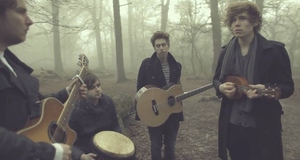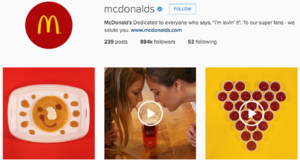From Elon Journal of Undergraduate Research in Communications VOL. 6 NO. 2Instagram and Branding: A Case Study of Dunkin' DonutsNext, three pictures featured an emotional appeal. The fi rst image focused on the fear or anxiety associated with not having a donut from Dunkin' Donuts. This was in the form of a prank video, featuring a frustrated and annoyed victim. The second featured a nostalgic element, through use of the "mom's homemade cooking" trope, with the picture featuring a friendly apron and homemade cookies. The third image focused on the joy or happiness that Dunkin' Donuts could provide, especially on a cold winter's day. The image showed a happy woman holding her coffee tightly, with an accompanying caption invoking a call-to-action for fans to spread the joy of Dunkin' Donuts. The posts were also analyzed to see if the photos included a fun or friendly aspect, as described in the overall social media strategy and brand positioning of Dunkin' Donuts on Instagram. To create fun elements, 10 posts used textual elements, visual elements, or both. Dunkin' Donuts employed a video of a prank, playful comments about products, a playful suggestion to rename fall "Pumpkin season," or other tactics. Two of the most fun examples included a photo of Abraham Lincoln and George Washington made out of coffee beans for President's Day and an Instagram contest to reward fans of Dunkin' Donuts for their dedication. V. DiscussionThe research question of this study was how Dunkin' Donuts uses Instagram to brand itself. Dunkin' Donuts uses both the textual and visual elements of Instagram together to create a fun and friendly social media experience for the fans of the brand. The brand utilizes its strong brand name and imagery by including its logo, the brand colors and the name when possible. These features occur through both visuals and text, creating a cohesive post, which strengthens the brand. The unique hashtags in six posts further attempt to create a unique fan based environment. Because of their brand centered content, such as #mydunkin, fans can use them specifi cally to upload and share pictures of Dunkin' Donuts products. Dunkin' Donuts largely uses seasonal and holiday themes throughout its Instagram posts. Use of popular, mainstream holidays, such as April Fools Day and Cinco de Mayo, along with smaller, brand related holidays, such as National Donut Day and the made-up SunDDay, provides the brand with a safe and trusted way to create content and gain the audience's attention. Products that complement the seasons, such as the Coolatta for summer and the Hot Chocolate or Latte Pumpkin Crème Brule for fall, help brand Dunkin' Donuts further by showing recognizable and popular products with matching seasonal imagery. Other research findings suggest that while Dunkin' Donuts uses a multitude of imagery and text to suggest its "fun and friendly" brand, it does so without frequently using emotional appeals. Only three visuals used emotional appeals and only one of them used the emotional appeal of joyfulness or happiness. Even the most fun-oriented visuals, such as the Cinco de Mayo picture featuring a "fiesta," did not include any fun imagery other than the colorful Coolatta products. When analyzed for positive and negative message framing, all of the visuals had positive message framing except for one. One of the most interesting aspects of the analysis is how little fans play a role in the Instagram posts of Dunkin' Donuts. Even as a people-oriented brand, which claims to engage fans in a fun and friendly way, the brand is lacking in their representation of fans. There were no fan photos shared by the brand on Instagram in the sample. Only two posts showed the faces of people: one man was featured in a prank video and one woman was shown in a post promoting a new Social Hub feature. Various hands and torsos were shown in the picture, but only as a way to display Dunkin' Donuts products. For a people-friendly brand, the actual consumers of Dunkin' Donuts were missing from Instagram. Interpretation of Findings and TheoryDunkin' Donuts has created a strong brand presence on Instagram through its content. The brand's prevalent use of brand name, logo, colors, and products has created a strong sense of visual branding on the social media app. If one were to see an Instagram post by Dunkin' Donuts, one would be able to recognize it as such immediately. Dunkin' Donuts has been able to create its brand on Instagram by creating a connection with fans through Dunkin' Donuts specific visuals. For a people-oriented brand, Dunkin' Donuts showed photos that do not reflect its social media strategy and execution. With only two visuals representing people, one showing a woman's face in a photo and the other the back of someone's head in a video, its visual strategy was not clearly consumer oriented. At this time, framing theory seems to only be slightly connected to the way Dunkin' Donuts brands itself on Instagram. The biggest "frame" or grouping of messages seems to be simply the use of Dunkin' Donuts products. Out of the 12 posts, 9 featured products. While there were fun and friendly elements throughout, there didn't seem to be any distinct "fun" frames. And while the posts were analyzed for positive or negative message framing, all were positive except for one. These findings suggest that Dunkin' Donuts had no distinct frames or messages featured or implied in Instagram posts and may not apply framing theory to strengthen Dunkin' Donuts brand on Instagram. VI. Conclusion In conclusion, Dunkin' Donuts does a strong job of branding itself on Instagram, the social media application rising with popularity as a tool for communicators to engage with fans of the brand through unique and engaging content. By using the brand name, logo, and color, as well as actionable hashtags and product images, Dunkin' Donuts is able to use its brand to post engaging content in order to connect with fans of the brand. And while framing theory does not appear to hold up as a strong theoretical basis for the branding of Dunkin' Donuts on Instagram, the company's use of branding strategies and tactics, both visually and textually, continues to help strengthen the brand on social media. Limitations of this study include the small sample size of 12 posts and the lack of a different coder for this study. Any additional Instagram research will be helpful for future research because the mobile application is the newest tool for communicators. Research on Instagram as a branding tool would be especially helpful to further understand communication theories and how they are connected to the social media app. Future research on branding and the framing theory should also look at a brand's total social media presence by observing and studying beyond Instagram. By studying multiple social media sites together, such as Facebook, Instagram, and Twitter, researchers may examine more evidence about branding to draw a stronger conclusion. Finally, future research should focus on framing theory in the context of social media and branding. Few scholarly articles were available to study the theory in this way, making it difficult to draw strong conclusions about its presence in branding on social media. AcknowledgmentsThis author is thankful to Don Grady, associate dean in the School of Communications at Elon University, for his supervision, support, and advice, without which this article could not be published. The author also appreciates Byung Lee, associate professor of communications at Elon University, and the numerous reviewers who have helped revise this article, as well as Lecturer Hal Vincent and Associate Professor Dan Haygood for providing a fundamental understanding of the subject matter and for inspiring creativity and motivation to explore the subject further. AuthorKally A. Lavoie, Strategic Communications, Elon University ReferencesAmerican Research Group. (2012). 10 rules for more effective advertising. Retrieved April 26, 2015, from http://americanresearchgroup.com/adrules/ Baran, S., & Davis, D. (1995). Mass communication theory: foundations, ferment, and future. Belmont, Calif.: Wadsworth Pub. Bevins, C. (2014). Get Schooled: A visual social semiotic analysis of Target's branding using Instagram. Master's thesis. Retrieved April 20, 2015, from http://digitalcommons.liberty.edu/cgi/viewcontent.cgi?article=1329&context=masters. Champagne, C., & Iezzi, T. (2014). Dunkin' Donuts and Starbucks: A tale of two coffee marketing giants. Retrieved April 25, 2015, from http://www.fastcocreate.com/3034572/coffee-week/Dunkin'-donuts-andstarbucksa-tale-of-two-coffee-marketing-giants Chong, D., & Druckman, J. N. (2007). Framing Theory. Annual Review of Political Science 10, 103-126. Retrieved from 10.1146/annurev.polisci.10.072805.103054. Costill, A. (2014). 30 Things you absolutely need to know about Instagram. Retrieved April 20, 2015, from http://www.searchenginejournal.com/30-things-absolutely-need-know-instagram/85991/ da Cunha, M. (2015). 10 Instagram marketing tips to make people love your brand. Retrieved April 26, 2015, from http://www.wordstream.com/blog/ws/2015/01/06/instagram-marketing de Vreese, H., Jochen P., & Holli A, C. (2001). Framing politics at the launch of the Euro: A cross-national comparative study of frames in the news. Political Communication. doi:10.1080/105846001750322934 Hu, Y., Manikonda, L., & Kambhampati, S. (2014). What we Instagram: A first analysis of Instagram photo content and user types. In ICWSM. AAAI. Retrieved April 20, 2015, from http://149.169.27.83/instagramicwsm.pdf. Huey, L. S., & Yazdanifard, R. (2014). How Instagram can be used as a tool in social network marketing. Master's thesis. Retrieved from http://www.academia.edu/8365558/How_Instagram_can_be_used_as_a_tool_in_social_network_marketing. Instagram for business. (2014). In Photoset. Retrieved April 26, 2015, from http://blog.business.instagram.com/post/101429436816/brands-using-instagram-as-a-canvas-for-seasonal Instagram. (2015). Retrieved April 19, 2015, from https://instagram.com/press/ Kats, R. (2013. Dunkin' Donuts puts Twitter at the center of new mobile campaign. Retrieved April 25, 2015, from http://www.mobilemarketer.com/cms/news/social-networks/14805.html Keller, K. (2009). Building strong brands in a modern marketing communications environment. Journal of Marketing Communications, 15, 139-155. doi:10.1080/13527260902757530 McClain, J. (2011). Media framing as brand positioning: Analysis of coverage linking Phish to the Grateful Dead. ProQuest Dissertations and Theses. Doctoral dissertation. Retrieved from http://magic.msu.edu:4550/resserv?genre=dissertations+&+theses&issn=&title=Media+framing+as+brand+positionin g:+Analysis+of+coverage+linking+Phish+to+the+Grateful+Dead&volume=&issue=&date=2011-0101&atitle=&spage=&aulast=McClain&sid=ProQ:ProQuest+Dissertations+&+Theses+A&I&isbn=97811 24690438&jtitle=&btitle= LA English North, N. S. (2011). Social Media's role in branding: A study of social media use and the cultivation of brand affect, trust, and loyalty. master of arts thesis. Retrieved from https://repositories.lib.utexas.edu/bitstream/handle/2152/ETD-UT-2011-12-4924/NORTH-THESIS.pdf?sequence=1 Perkins, M. (2014). How to develop a strong visual brand on social media. Retrieved April 26, 2015, from http://blog.hubspot.com/marketing/strong-brand-voice-social-media Sohn, T. (2012). How Dunkin' Donuts uses social media. Retrieved April 25, 2015, from http://www.adweek.com/socialtimes/how-dunkin-donuts-uses-social-media/101757 Stampler, L. (2012). Here's how Dunkin' Donuts does Instagram. Retrieved April 25, 2015, from http://www.businessinsider.com/dunkin-donuts-does-instagram-for-halloween-2012-10 Tsai, S. (2007). Message framing strategy for brand communication. Journal of Advertising Research, 364364. doi:10.2501/S00218499070 7037 7 Wasike, B. S. (2013). Framing news in 140 characters: How social media Editors frame the news and interact with audiences via Twitter. Global Media Journal, Canadian Edition, 6(1), 5–23. Weaver, D. H. (2007). Thoughts on agenda setting, framing, and priming. Journal of Communication, 57(1), 142–147. doi:10.1111/j.1460-2466.2006.00333.x Suggested Reading from Inquiries Journal
Inquiries Journal provides undergraduate and graduate students around the world a platform for the wide dissemination of academic work over a range of core disciplines. Representing the work of students from hundreds of institutions around the globe, Inquiries Journal's large database of academic articles is completely free. Learn more | Blog | Submit Latest in Business & Communications |



















